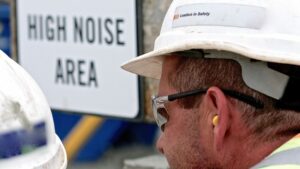
Acoustic design is a very important element in industrial workplaces. The goal of acoustic design is to offset the negative effects of continuous noise in an industrial environment. Whether the noise is from machinery or is produced by sounds bouncing off hard surfaces, loud and ongoing sound can have a significant impact on safety and productivity in working environments. This is why it’s essential that your industrial ventilation systems are designed with acoustics in mind.
OSHA standards require employers to take preventative action if the average noise exposure during an 8 hour workday is 85 decibels or higher. The good news is that incorporating acoustic solutions into your system can be successfully completed by experienced industrial ventilation design professionals. These solutions will help create a safer atmosphere for your employees while ensuring your operational processes are still running efficiently.
Take the first step towards making sure your workspace meets both safety and comfort standards. Schedule an initial noise level assessment for your facility by contacting our team at Eldridge today.
The Role of Acoustic Design in Industrial Settings
Acoustic design is a fascinating and incredibly important field of study. It involves the science of sound and how it behaves in different environments, and in industrial settings, it can have a significant impact on worker safety and productivity.
Essentially, acoustic design is the process of creating spaces that optimize operational performance and allow for clear communication while minimizing unwanted noise. According to OSHA, if you need to raise your voice to grab the attention of someone three feet away, the noise level in your workplace is considered unsafe. In an industrial setting, effective acoustic design can mean the difference between a calm, productive workspace and a chaotic, stressful one. It’s an often-overlooked aspect of workplace safety and one that deserves more attention and consideration.
Long-Term Exposure to Improperly Designed Sound Can Harm Employees and Machines
Sound is an integral part of our daily lives. But did you know that not all sounds are created equal? Improperly designed sounds, particularly in the workplace, can be harmful to both employees and machines. Prolonged exposure to loud noises can lead to noise-induced hearing loss, a condition that is irreversible and can have a significant impact on quality of life.
On top of this, the vibrations caused by high levels of noise can damage machinery, leading to costly breakdowns and lost productivity. As employers, it is important to ensure that workplaces are designed in a way that minimizes the risk of harm from sound, for the wellbeing of both workers and machinery.
Components of an Industrial Ventilation System that Reduce Noise
Industrial ventilation systems are crucial for ensuring a clean and safe work environment in many industries. By incorporating certain components into these systems, such as acoustic silencers and enclosures, noisy machinery and equipment can be muffled to create a more focused and productive workplace.
There are a variety of industrial ventilation system components that help address noise issues. The best combination of components for your system will be selected based on your space and noise level. These may include:
- Fan silencers
- Absorptive silencers
- Reactive silencers
- Vent silencers
- ASME-code silencers
- High pressure vent silencers
- Blowdown silencers
- Sound dampening products
- Enclosures
Key Steps in Successful Acoustic Design
Designing a system to reduce noise is a complex process that requires careful consideration and planning. The first step is to identify the source of the noise, whether it’s from machinery, worker activity, or external factors.
Once the source is determined, the next step is to measure and analyze the noise levels. Objective metrics such as sound pressure levels, frequency spectra, and reverberation time are used. These measurements help identify problem areas and guide the implementation of effective noise mitigation strategies. Precise measurements are important here, as the sound-reducing components chosen for the system will be based on these specific noise levels.
The system designer will then assess whether these acoustic components can be integrated into the existing ventilation system without compromising air quality. Proper ventilation must be maintained to ensure temperature, humidity, and air quality are regulated. They will also confirm that the refined system design will not interfere with operational efficiencies.
Lastly, once the measurements, calculations, and CAD drawings are complete, an information package and installation plan will be compiled.
Measuring a Successful Acoustic Environment in an Industrial Application
Creating a successful acoustic environment in an industrial application is crucial to ensure efficient and safe operations. But what exactly constitutes success when it comes to acoustics in this context? A successful acoustic environment is one that minimizes noise pollution, provides comfortable working conditions, and meets relevant OSHA standards and regulations.
To measure success once acoustic components have been integrated into your industrial ventilation system, we can conduct a follow-up sound measurement and analysis using the same objective metrics as our initial testing. These measurements help confirm that your noise mitigation efforts are meeting the goal of reducing sound to safe levels.
So while industrial ventilation systems may be primarily aimed at improving safety, they also have the added bonus of creating a quieter and more efficient work environment. By investing in a successful acoustic environment, businesses can boost productivity and ensure the well-being of their employees.
Industrial Ventilation Systems from Eldridge
Noise can be a serious concern in industrial workspaces, causing hearing damage, increased stress, and decreased productivity. Through the design of a well-thought-out acoustic environment, noise can be effectively managed and reduced in industrial workplaces. This helps keep your employees safe and reduces unnecessary stress on machinery.
With our years of experience in designing industrial ventilation systems, Eldridge can create the proper acoustic design for your facility. Our team of engineers will work with your requirements to create a solution tailored specifically for you. Contact us for a quote today and get started on creating an effective acoustic environment in your workplace.
